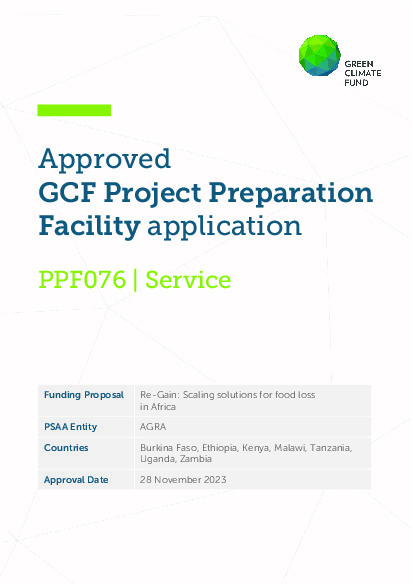Re-Gain: Scaling solutions for food loss in Africa
According to the FAO, 30%1 of food produced for human consumption is lost or wasted along the supply chain every year. In Africa, the losses are even higher, ranging between 30% and 50%. This equates to 1.3 billion2 metric tons of food that fails to reach consumers, in a context of increasing food insecurity. Reports have estimated that lost or wasted food could be used to feed approximately 1.6 billion people every year3 . In addition, food loss has a high carbon footprint as it leads to unnecessary deforestation, land conversion, and the wastage of water, nutrients, biodiversity and other resources.
Climate change exacerbates post-harvest food losses due to several factors: high temperature and heat causing spoilage of produce, high humidity reducing shelf life and product quality, changes in precipitation patterns leading to on-farm crop loss, decreased precipitation causing end-of-season food loss through shrinkage, underdeveloped seeds, tubers and fruits, Increased precipitation leading to shattering, flooding and wastage, and a higher risk of aflatoxin contamination and associated market and health risks.
Food losses lead to less food being available per unit per person. This is compounded by the low productivity rates per unit of land, and low overall productivity could have negative impacts on food security and livelihoods, thereby reducing the resilience capacities of people to cope with climate change shocks. Reducing food loss will therefore reduce the need for the expansion of land, land use changes and deforestation. According to the FAO 2023, small-scale farming is linked to most agriculture-driven deforestation in all regions of the world. To varying degrees across regions, Africa accounts for a 96% share of agriculture-driven deforestation, with 80 percent attributed for cropland and 16 percent to livestock.
Well-functioning markets and trade systems create the necessary incentives for actors including farmers and traders to invest and to make efforts toward efficient solutions for harvesting, handling, storage, transporting, and packaging of agricultural commodities. This contributes to reducing food losses under changing climates which means:
- More food is produced per unit of land, labor, water and nutrients leading to less GHG emissions per unit consumed. (mitigation)
- Less need to expand land under cultivation (deforestation) which means land can be used/preserved for carbon sequestration and other ecosystem services (mitigation)
- Improved food security and increased income as farmers will be more food secure hence more resilient to climate change (adaptation)
- Reduced health risks due to pre and post-harvest infestation by mycotoxins/aflatoxigenic strains at the pre-harvest stage (adaptation)
